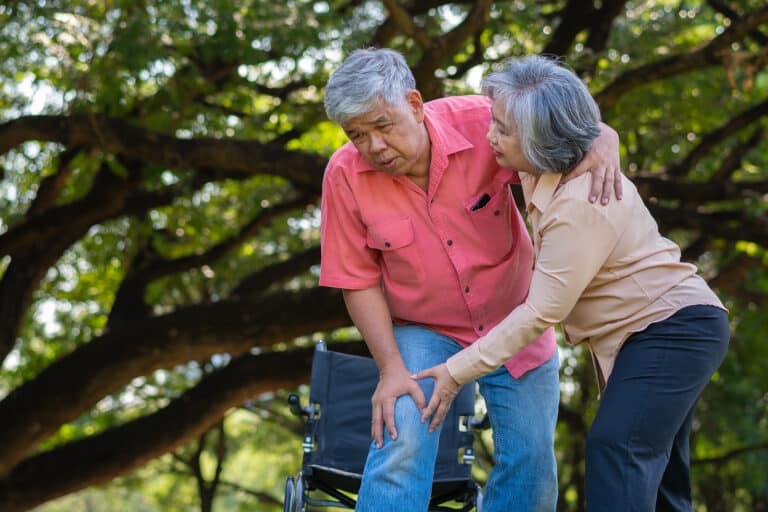As the air turns crisper and the trees don their multicolored hues, we are captivated by nature’s breathtaking transformation. While we marvel at the shift in seasons, its is also a time to reflect on a different kind of fall – one that affects our well-being. Just as leaves fall from their branches, our focus turns to preventing the unintentional fall that can pose risks, especially for our elderly loved ones. In this season of change, we will begin a journey to explore the art of fall prevention. Let’s look at several measures you can take to minimize the risk of falls in your home and in doing so, it will help us move through life’s stages with confidence, balance and grace.
Home and Personal Tips for Fall Prevention:
Here are some preventative tips that you can do on your own:
- Start by removing tripping hazards: Checking your living space regularly for any potential tripping hazards such as loose rugs, clutter, or uneven flooring. Remove or secure items to create a clear and safe pathway. If you are using a walker or wheelchair, ideally there should be a clear width of at least 36 inches (91 cm) for easy mobility.
- Consider using an assistive device like canes or walkers, as recommended by healthcare professionals, to aid mobility and prevent falls. Also, doing a walk through of your home with the mobility assistive device (wheelchair, walker or cane) can assist you seeing your home through the eyes of your mobility compromised loved one, and help you better ‘fall proof’ your home, room by room.
- Wearing appropriate footwear: Wear comfortable, supportive shoes with non-slip soles. Avoid bulky loose slippers, high heels, bare feet, and socks without grips.
- Using non-slip mats: Placing non-slip mats in areas that are prone to getting wet, such as the bathroom, kitchen, laundry room reduces the risk of slipping.
- Keeping the walkways clear: Ensure that pathways are free from obstacles, cords, and low furniture that could impede walking.
- Bathroom safety: Use a non-slip bathtub mat or adhesive strips in the shower. Consider using a shower chair or bench to make bathing safer.
- Organize frequently used items: Keep essential items within easy reach to avoid the need for excessive bending or reaching.
- Monitor medications: Some medications can cause dizziness or imbalance. Ensure the appropriate healthcare provider regularly reviews your medications and potential side effects. Remember, communication with their pharmacist is key. Ask questions, voice concerns, and seek clarification about medications during appointments.
- Regular vision and hearing check-ups: Poor vision or hearing can increase the risk of falls. Ensure regular check-ups and ensure that eyeglasses and hearing aids are appropriately used.
- Regular exercise: Engage in physical activities that improve strength, balance, and flexibility. Regular exercise is essential to improve circulation, prevent muscle atrophy, enhance cardiovascular health, and promotes overall well-being. A few examples of wheelchair bound exercises that individuals can engage in are: Seated Yoga, wheelchair Aerobics and strength training. It is essential to consult with a healthcare professional or a physical therapist to tailor an exercise routine that suits the individual’s abilities and medical conditions.
- Communicate openly: Encourage open communication about concerns and any difficulties they/you might be experiencing to address any potential fall risks.
Here are some preventive tips that you may need help with:
1. Furniture placement: Arrange furniture to create a clear path throughout the home. Ensure there is enough space to maneuver.
2. Improve lighting: Ensure that all areas of the home are well-lit, especially hallways, staircases, and entrances. Use nightlights in the bedroom, hallways, and bathrooms to provide visibility during the night.
3. Install handrails and grab bars: Place sturdy handrails along both sides of staircases and grab bars in the bathroom near the toilet and shower/bathtub to assist with balance and stability.
4. Consider home modifications: Depending on the individual’s needs, consider making home modifications like installing ramps for steps or widening doorways to accommodate mobility aids.
So, just as the trees shed their leaves to prepare for the coming winter, we too can help shed the uncertainty that accompanies preventable falls. By securing rugs, illuminating pathways, and preparing our homes with handrails, we’ve given our elderly loved ones the confidence of being able to move through their homes safely. With these precautions in place, we can stroll through life’s journey with a renewed sense of assurance, knowing that just as autumn ushers in transformation, our commitment to safety ushers in a season of strength and security.
If you or an ageing loved one are considering Home Care in Spruce Grove, please contact the caring staff at Serving Hands Senior Care today. Call (780) 963-1516
Premiere Home Health and Senior Home Care services in Spruce Grove, Stony Plain, Devon, St. Albert, Edmonton, Onoway, Leduc, Parkland County and surrounding communities since 2016.
- Seeing Clearly: Glaucoma Awareness for Seniors - March 10, 2025
- The Sounds of Life: Hearing Aid Care for Seniors - March 3, 2025
- Save a Life Today!! ❤️ - February 18, 2025








